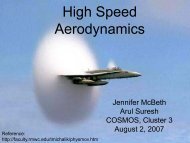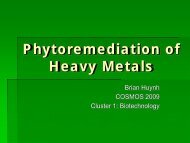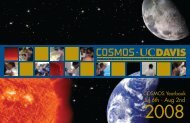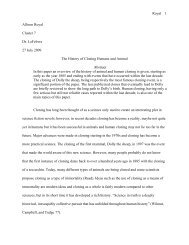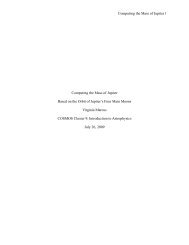You also want an ePaper? Increase the reach of your titles
YUMPU automatically turns print PDFs into web optimized ePapers that Google loves.
<strong>Dendritic</strong>‐<strong>Cell</strong> <strong>Vaccine</strong>:<br />
A New and Promising Approach to Treating<br />
Cancers<br />
Janet La<br />
UCD <strong>COSMOS</strong> Cluster 1: Biotechnology<br />
Mentor: Professor Paul Feldstein<br />
Teacher Fellow: Rebecca Sela
<strong>Vaccine</strong>s<br />
<strong>Vaccine</strong>s are biological<br />
(mostly microbial) preparations<br />
that induce the body to<br />
produce an immune response<br />
and boost the immune system’s<br />
ability against infection. The<br />
body will recognize the foreign<br />
agent, destroy it and memorize<br />
it for future infections by the<br />
same microorganism.
Stimulation of the Immune System<br />
Leukocytes (white blood cells) play<br />
a key role in the immune system.<br />
They include macrophages,<br />
neutrophils and natural killer<br />
cells.<br />
• Some patrol the body seeking<br />
foreign agents, diseased and<br />
damaged cells to destroy. (in<br />
non‐specific defense)<br />
• Others, called lymphocytes work<br />
against specific threats.
Example of Lymphocytes<br />
– B cells : make antibodies, which<br />
bind to and mark the foreign<br />
invaders or abnormal cells for<br />
destruction.<br />
– Cytotoxic T cells: kill the foreign<br />
agents and abnormal cells by<br />
causing apoptosis.<br />
• Helper T cells and <strong>Dendritic</strong> cells<br />
help out by activating B cells<br />
and killer T cells.
Cancer <strong>Vaccine</strong>s<br />
<strong>Vaccine</strong>s work by activating B cells and killer T cells and “directing”<br />
them to recognize and attack specific types of cancer.<br />
• Antigens, which are substances that stimulate a specific immune<br />
response, are introduced.<br />
• They can be a protein or other molecules that are in the surface or inside of<br />
the invader cells.<br />
• These antigens will promote the generation of antibodies.<br />
The vaccines, which contain cancerous cells or antigens, will stimulate<br />
the immune system to generate cells that kill the cancer cells and<br />
prevent the cancer from relapsing.<br />
There are two main categories of cancer vaccines: preventive vaccines<br />
and treatment vaccines.
Preventive <strong>Vaccine</strong>s<br />
Preventive <strong>Vaccine</strong>s are designed to prevent the development<br />
of cancer in healthy people.<br />
They essentially work like normal vaccines by producing<br />
immunity against the particular virus or microbe that cause<br />
infections that lead to cancer.<br />
The FDA has approved two types<br />
of preventive vaccines.<br />
•A vaccine against the Hepatitis B<br />
virus, which leads to liver cancer.<br />
•A vaccine against Human<br />
Papillomavirus types 16 and 18,<br />
which are responsible for cervical<br />
cancer.
Treatment <strong>Vaccine</strong>s<br />
Designed to treat existing cancers by stimulating<br />
the immune system to attack cancer cells.<br />
Effective vaccines are hard to develop because in many cases, cancers escape<br />
detection by the immune system because of self antigens and the vaccines<br />
themselves often times weaken the immune system’s natural ability<br />
against cancer cells.<br />
The FDA has not approved any cancer treatment vaccines.<br />
There are five types being developed:<br />
• Antigen <strong>Vaccine</strong>s –use tumor‐specific antigens<br />
• Anti‐idoiotype <strong>Vaccine</strong>s –use antibodies that act as antigens<br />
• <strong>Dendritic</strong> <strong>Cell</strong> <strong>Vaccine</strong>s –use dendritic cells to display antigens<br />
• DNA vaccines –insert bits of DNA to increase production of antigens<br />
• Tumor <strong>Cell</strong> <strong>Vaccine</strong>s –use killed cancer cells
<strong>Dendritic</strong> <strong>Cell</strong> <strong>Vaccine</strong>s<br />
• <strong>Dendritic</strong> <strong>Cell</strong> vaccines involve using <strong>Dendritic</strong> cells from the cancer<br />
patient to stimulate immune responses.<br />
• The <strong>Dendritic</strong> <strong>Cell</strong> is a scarce immune<br />
cell which recognizes, processes and<br />
presents foreign antigens to the T‐cells<br />
of the immune system. They constantly<br />
roam around the body and function as<br />
antigen‐presenting cells when they<br />
discover antigens, calling on other cells<br />
for help. However, <strong>Dendritic</strong> cells are<br />
usually not present in a large enough<br />
quantity to produce a strong immune<br />
response. They are now generated by<br />
the millions in labs.
<strong>Dendritic</strong> <strong>Cell</strong> <strong>Vaccine</strong>s – cont.<br />
• To make <strong>Dendritic</strong> cell vaccines,<br />
scientists harvest peripheral blood<br />
mononuclear cells, such as<br />
lymphocytes or monocytes, from the<br />
blood of the patient and grow them<br />
in a laboratory in large amounts<br />
while exposing them to antigens<br />
from the patient’s own cancer. By<br />
doing that, autologous cancer<br />
vaccines are created.<br />
• After the <strong>Dendritic</strong> cell takes up the<br />
antigens, they will be displayed on<br />
its surface.
v<br />
• After the generation of<br />
<strong>Dendritic</strong> cells and the<br />
taking up of the antigens,<br />
the cells, with antigens<br />
presented on their surfaces,<br />
are injected back to the<br />
patient.<br />
• The injected <strong>Dendritic</strong> cells<br />
along with the antigens<br />
activate the production of<br />
the cytotoxic T‐cells, which<br />
will be programmed to<br />
recognize and destroy the<br />
cancer cells.
Researchable Question<br />
Are mature dendritic cells more effective than<br />
immature dendritic cells in inducing an immune<br />
response when used in vaccination against glioma<br />
in mice
Mature vs. Immature <strong>Dendritic</strong> <strong>Cell</strong>s<br />
• Immature dendritic cells are commonly called<br />
veiled cells because of their veils instead of<br />
dendrites on mature cells.<br />
• They are found in their immature state in the<br />
blood.<br />
• When activated, dendritic cells migrate to the<br />
lymphoid tissues and interact with T and B<br />
cells.<br />
• Inflammatory stimuli switch dendritic cells to<br />
an immunostimulatory mode and they are<br />
“matured.”<br />
• During maturation, the cells will grow branches<br />
called dendrites.<br />
The specifics of the workings of dendritic cells are<br />
not yet fully understood and the maturity level<br />
of dendritic cells may be a very important<br />
factor in effectiveness of immunotherapies.
What is Glioma<br />
• A type of cancer that starts in the brain or spine. It can spread<br />
within the nervous system but usually do not spread to other<br />
parts of the body.<br />
• Annually about 17,000 Americans are diagnosed with gliomas<br />
and the median survival of patients with glioblastoma<br />
multiforme, which is the most common form of glioma, is<br />
around 15 months.<br />
These tumors are categorized<br />
by location.<br />
Supratentorial tumors, in the<br />
cerebrum, affects mostly adults.<br />
Infratentorial tumors, in the<br />
cerebellum, affects mostly<br />
children.
Why <strong>Dendritic</strong>‐cell vaccines for glioma<br />
• Because despite advances in chemotherapy,<br />
radiation and surgery, for many glioma patients all<br />
these methods are ineffective.<br />
• The location of these tumors make the traditional<br />
methods tricky, since using each radiation treatment<br />
kills off many healthy and crucial brain cells.<br />
• <strong>Dendritic</strong>‐cell vaccine seems to be the most<br />
promising for a targeted location in this type of<br />
cancer.
Materials<br />
• Mice implanted with<br />
tumor cells<br />
• Leukapheresis Machine<br />
• Density Gradient<br />
Centrifuge<br />
• Counterflow Centrifuge<br />
• Tissue Culture Flasks<br />
• GM‐CSF (granulocyte<br />
monocyte‐colony<br />
stimulating factor)<br />
• Human Serum with X‐<br />
VIVO medium<br />
• Interleukin‐4<br />
• KLH (keyhole limpet<br />
hemocyanin)<br />
• Glioma Antigens:<br />
EGFRvIII, tenascin and<br />
GP 200<br />
• ELISPOT Assay Machine
Experimental Design<br />
• I will obtain 7 groups of mice with brain tumors as<br />
my testing subjects. Three of the groups will be<br />
treated with mature dendritic cell vaccines, three<br />
groups will be treated with immature dendritic cell<br />
vaccines and the last group will not be given any<br />
treatment.
Experimental Design – cont.<br />
• For the groups that will be treated with mature dendritic cell<br />
vaccines, they will be labeled MDC‐1, MDC‐2 and MDC‐3.<br />
Similarly, those that would be treated with immature<br />
dendritic cell vaccines will be labeled IDC‐1, IDC‐2 and IDC‐3.<br />
• White blood cells will be harvest and grown in culture.<br />
– In MDC‐1 and IDC‐1 groups, dendritic cells will be grown and not<br />
pulsed before reinjecting back into mice.<br />
– In MDC‐2 and IDC‐2 groups, dendritic cells will be pulsed with KLH<br />
before reinjecting back into mice.<br />
– In MDC‐3 and IDC‐3 groups, dendritic cells will be pulsed with glioma<br />
antigens: EGFRvIII, tenascin and GP 240.<br />
• The seven mice groups will be tested by ELISPOT Assay to<br />
observe immune responses.
Material Details<br />
• GM‐CSF (granulocyte monocyte‐colony stimulating factor)<br />
– Promotes the development of immature dendritic cells from<br />
monocytes<br />
• Human Serum with X‐VIVO medium<br />
– Medium in which human cells are cultured<br />
• Interleukin‐4<br />
– Activate the growth of naïve immune cells<br />
• KLH (keyhole limpet hemocyanin)<br />
– A large protein extracted from the giant keyhole limpet Megathura<br />
crenulata. It can act as a carrier protein<br />
• MCM (monocyte‐conditioned medium)<br />
– Medium generated from white blood cells that induces the maturation<br />
of immature dendritic cells
Techniques<br />
• Leukapheresis is a lab procedure in<br />
which leukocytes (the white blood<br />
cells) are separated from the blood.<br />
• Counter flow Centrifugation is a<br />
method to separate cells of different<br />
sizes.<br />
• Density Gradient Centrifugation is a<br />
method which scientists use to<br />
separate intact organelles from a cell.<br />
These centrifuge machines involve<br />
setting up a density variation or<br />
gradient in the tubular centrifuge<br />
such as gradients of sucrose<br />
solutions. In the case of this<br />
experiment, peripheral blood<br />
mononuclear cells are separated<br />
from the white blood cells extracted.
Techniques – cont.<br />
• The ELISPOT assay is a highly sensitive<br />
assay for analysis of cell activation at<br />
very detailed levels. It is a very common<br />
method for monitoring immune<br />
responses in humans and animals.<br />
• The ELISPOT assay is very useful for<br />
analyzing specific immune responses to<br />
antigens as proteins or peptide. The<br />
assay can be used to identify and<br />
differentiate between responses by<br />
different types of T cells according to<br />
the cytokine secretion pattern.<br />
• The assay quantifies the secretion of<br />
cytokines, which are signaling<br />
molecules used for communication by T<br />
cells.
Procedures<br />
• Making <strong>Vaccine</strong>s<br />
1. Take blood samples from each mice and perform<br />
leukapheresis.<br />
2. From all samples, isolate PBMCs (peripheral blood<br />
mononuclear cells) using density gradient centrifugation.<br />
3. Separate half of the PBMCs and culture them to<br />
generate MCM (monocyte‐conditioned medium)<br />
4. Use counterflow centrifugation to isolate monocytes<br />
from the remaining PBMCs.<br />
5. Grow monocytes in tissue culture flasks with GM‐CSF, HS<br />
with X‐VIVO medium and IL‐4.<br />
6. To groups MDC‐1, MDC‐2, and MDC‐3, add the<br />
autologous MCM to induce the maturation of the<br />
dendritic cells. <strong>Cell</strong>s will mature in about 10 days. s
Procedures – cont.<br />
7. To groups MDC‐1 and IDC‐1, leave unpulsed.<br />
8. To groups MDC‐2 and IDC‐2, pulse with KLH protein.<br />
9. To groups MDC‐3 and IDC‐3, pulse with glioma antigens<br />
EGFRvIII, tenascin and GP 240.<br />
MDC<br />
MDC +<br />
KLH<br />
MDC +<br />
EGFRvIII,<br />
tenascin,<br />
GP240<br />
No<br />
Treatment<br />
IDC<br />
IDC +<br />
KLH<br />
IDC +<br />
EGFRvIII,<br />
tenascin,<br />
GP240
Procedures – cont.<br />
• Reinjection of <strong>Cell</strong>s – Clinical Trial<br />
10. After 5 days, inject the cell vaccines back into each<br />
corresponding mice.<br />
11. 1 week after the injection, collect blood samples from<br />
each mice for immunological monitoring.<br />
12. Use ELISPOT assay to assess the amount of antigenspecific<br />
T cells and the amount of antibodies against KLH<br />
and the glioma antigens.<br />
12. Vaccinate and evaluate all groups of mice weekly.<br />
13. Measure tumor size to check for the halting of growth
Possible Results<br />
I think that my results will show the mature dendritic<br />
cells to be more effective at inducing immune<br />
responses in mice because after maturation,<br />
dendritic cells express high levels of co‐stimulatory<br />
molecules, which many increase cell adhesion and<br />
enhance T cell activation.<br />
I think the mice injected with mature dendritic cells<br />
plus glioma antigens will live the longest and have a<br />
longer period of halting growth of the brain tumor.
Works Cited<br />
• Amano, Takayuki, et al. "Antitumor effects of vaccination with dendritic cells<br />
transfected with modified receptor for hyaluronan‐mediated motility mRNA in<br />
a mouse glioma model." J Neurosurg 106 (Apr. 2007): 638‐645.<br />
• Bahn, Duke K., and Haakon Ragde. "Cancer Cryo‐Immunotherapy: A Battle<br />
Between the Immune System and Cancer." PCRI Insights 9.1 (2006). Prostate<br />
Cancer Research Institute. 29 July 2009 .<br />
• De Vries, Jolanda M., et al. "Maturation of Dendriic <strong>Cell</strong>s is a Prerequisite for<br />
Inducing Immune Responses in Advanced Melanoma Patients." Clinical Cancer<br />
Research 9 (Nov. 2003): 5091‐5100.<br />
• <strong>Dendritic</strong> <strong>Cell</strong> Therapy for Cancer. 29 July 2009 .<br />
• Dhodapkar, Madhav V., et al. "Antigen‐specific Inhibition of Effector T cell<br />
Function in Humans after Injection of Immature <strong>Dendritic</strong> <strong>Cell</strong>s." J. Exp.<br />
Med. 193.2 (2001): 233‐238.<br />
• Ebben, Johnathan D., Brandon G. Rocque, and John S. Kuo. "Tumour <strong>Vaccine</strong><br />
Approaches for CNS Malignancies ‐ Progress to Date." Drugs 69.3 (2009):<br />
241‐249.<br />
• ELISPOT. 29 July 2009 .<br />
• "Glioma." Gliomas ‐ Diagnosis and Treatment Options at Mayo Clinic. 29 July 2009<br />
.
Works Cited – cont.<br />
• How Cancer <strong>Vaccine</strong>s will work. 29 July 2009 .<br />
• Kochar, Preeti Gokal. "Cancer <strong>Vaccine</strong>s." CSA Illumina. Jan. 2006. 29 July 2009<br />
.<br />
• Naylor, Mark F. "Melanoma <strong>Vaccine</strong>s." Dermatology Online Journal 6.1 (2000).<br />
Department of Dermatology, University of Oklahoma Health Sciences Center .<br />
29 July 2009 .<br />
• Parmiani, Giorgio, et al. "Cancer Immunotherapy with Peptide‐Based <strong>Vaccine</strong>s:<br />
What have we achieved Where are we going" Journal of the National Cancer<br />
Institute 94.11 (2002): 805‐818.<br />
• <strong>Vaccine</strong>s Definition ‐ Medical Dictionary. 29 July 2009<br />
.<br />
• Yamanaka, Ryuya. "<strong>Dendritic</strong>‐<strong>Cell</strong>‐ and peptide‐based vaccination strategies for<br />
glioma." Neurosurg Rev 32 (Mar. 2008): 265‐273.
Images<br />
• http://looi5.files.wordpress.com/2009/04/bacteria1.jpg<br />
• https://meyerbio1b.wikispaces.com/file/view/strep_throat_bacteria.jpg<br />
• https://mywebspace.wisc.edu/kajacobson3/web/MS21/images/Autoimmune%20R<br />
esponse.jpg<br />
• http://encarta.msn.com/media_461519550_761575681_‐1_1/Lymphocyte.html<br />
• http://www.csa.com/discoveryguides/cancer/images/fig5.jpg<br />
• http://www.astrographics.com/GalleryPrintsIndex/GP2008.html<br />
• http://www.aecom.yu.edu/aif/gallery/sem/sem.htm<br />
• http://dermatology.cdlib.org/DOJvol6num1/transactions/melanoma/fig013.gif<br />
• http://www.new‐science‐press.com/browse/immunity/illustrations/4/<br />
• http://www.40kradio.com/wp‐content/uploads/2009/04/question‐mark‐dice.jpg<br />
• http://www.markmillermusic.org/blog/2009/01/09/<br />
• http://www.chiron.com/images/library/hbv.jpg<br />
• http://davispestcontrol.com/services<br />
• http://chemistry.umeche.maine.edu/CHY431/Antibody.jpg







